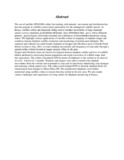| dc.description.abstract | The use of satellite GPS/GSM-collars for tracking wild animals’ movement and distribution has become
popular in wildlife conservation particularly for the endangered wildlife species. In Kenya, satellite
collars are frequently being used to monitor movements of large mammal species such as elephants
(Loxodanta africana), lions (Panthera leo), grevy zebras (Equuis grevyi), spotted hyenas (Crocuta
crocuta) and wildebeests (Conochaetes taurinus) among others. We highlight various applications of
satellite collars in mapping of elephant ranges and corridors, human-elephant conflict resolution and
monitoring of translocated elephants. We captured and collared two adult female elephants in Siyapei
and Olooltoto areas of Narok North district in June to July, 2011, to track elephant movements and
frequency of crop raids through a special collar website located at ranger security office in the area.
Siyapei and Olooltoto areas are known for frequent human elephant conflict and loss of wildlife
habitat attributed to increasing human population and rapid conversion of wildlife range land into
agriculture. The collars transmitted GPS locations of elephants to the website at an interval of every
4 hours for 2 months. Wardens and rangers were able to monitor the elephant movements from the
website and responded to crop raid in time hence minimizing crop damages and reducing vehicle
patrol costs. The collar results helped KWS to identify elephant herds for translocation from Siyapei
to Masai Mara NR. The translocated elephants were further monitored using satellite collars to ensure
that they settled in the new area. We also report various challenges and experiences of using collars
for elephant monitoring in Kenya. | en_US |

